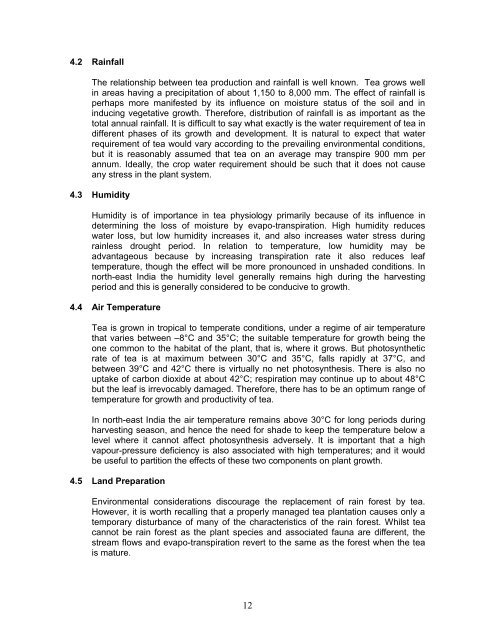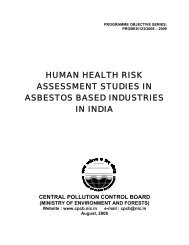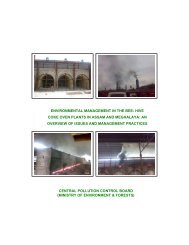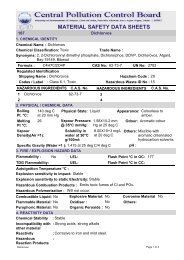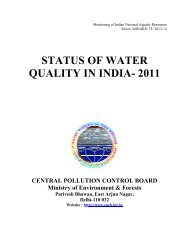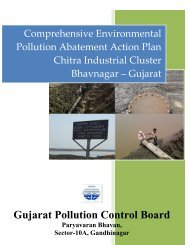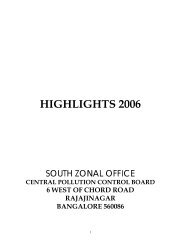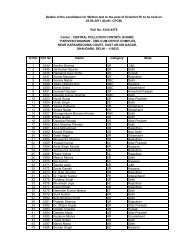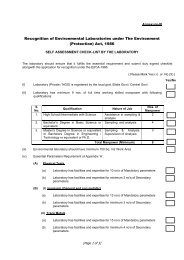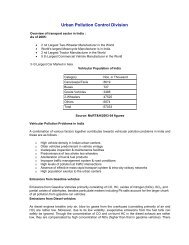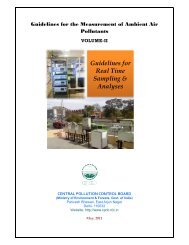FOREWORD - Central Pollution Control Board
FOREWORD - Central Pollution Control Board
FOREWORD - Central Pollution Control Board
Create successful ePaper yourself
Turn your PDF publications into a flip-book with our unique Google optimized e-Paper software.
4.2 Rainfall<br />
The relationship between tea production and rainfall is well known. Tea grows well<br />
in areas having a precipitation of about 1,150 to 8,000 mm. The effect of rainfall is<br />
perhaps more manifested by its influence on moisture status of the soil and in<br />
inducing vegetative growth. Therefore, distribution of rainfall is as important as the<br />
total annual rainfall. It is difficult to say what exactly is the water requirement of tea in<br />
different phases of its growth and development. It is natural to expect that water<br />
requirement of tea would vary according to the prevailing environmental conditions,<br />
but it is reasonably assumed that tea on an average may transpire 900 mm per<br />
annum. Ideally, the crop water requirement should be such that it does not cause<br />
any stress in the plant system.<br />
4.3 Humidity<br />
Humidity is of importance in tea physiology primarily because of its influence in<br />
determining the loss of moisture by evapo-transpiration. High humidity reduces<br />
water loss, but low humidity increases it, and also increases water stress during<br />
rainless drought period. In relation to temperature, low humidity may be<br />
advantageous because by increasing transpiration rate it also reduces leaf<br />
temperature, though the effect will be more pronounced in unshaded conditions. In<br />
north-east India the humidity level generally remains high during the harvesting<br />
period and this is generally considered to be conducive to growth.<br />
4.4 Air Temperature<br />
Tea is grown in tropical to temperate conditions, under a regime of air temperature<br />
that varies between –8°C and 35°C; the suitable temperature for growth being the<br />
one common to the habitat of the plant, that is, where it grows. But photosynthetic<br />
rate of tea is at maximum between 30°C and 35°C, falls rapidly at 37°C, and<br />
between 39°C and 42°C there is virtually no net photosynthesis. There is also no<br />
uptake of carbon dioxide at about 42°C; respiration may continue up to about 48°C<br />
but the leaf is irrevocably damaged. Therefore, there has to be an optimum range of<br />
temperature for growth and productivity of tea.<br />
In north-east India the air temperature remains above 30°C for long periods during<br />
harvesting season, and hence the need for shade to keep the temperature below a<br />
level where it cannot affect photosynthesis adversely. It is important that a high<br />
vapour-pressure deficiency is also associated with high temperatures; and it would<br />
be useful to partition the effects of these two components on plant growth.<br />
4.5 Land Preparation<br />
Environmental considerations discourage the replacement of rain forest by tea.<br />
However, it is worth recalling that a properly managed tea plantation causes only a<br />
temporary disturbance of many of the characteristics of the rain forest. Whilst tea<br />
cannot be rain forest as the plant species and associated fauna are different, the<br />
stream flows and evapo-transpiration revert to the same as the forest when the tea<br />
is mature.<br />
12


